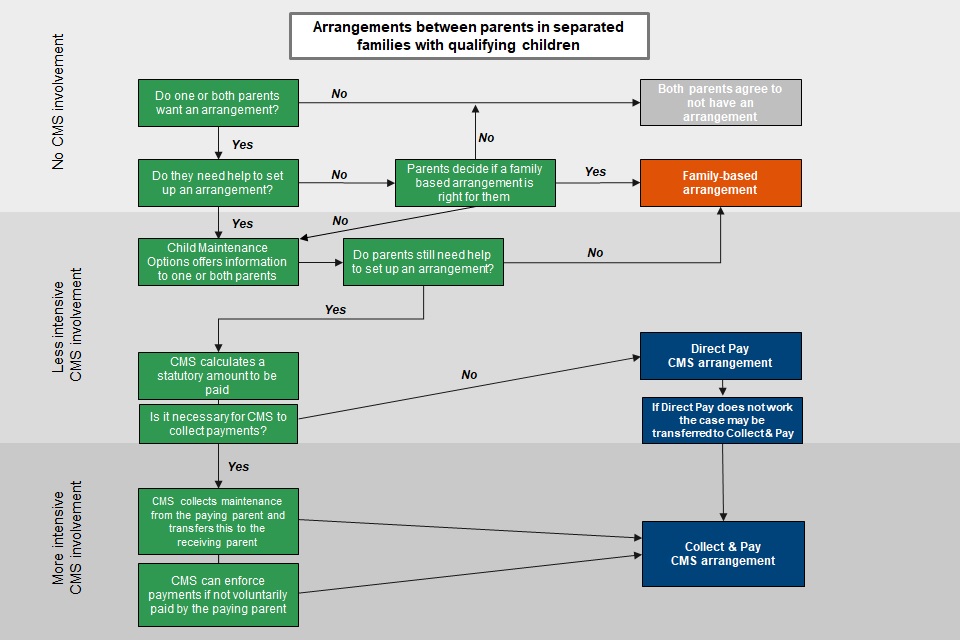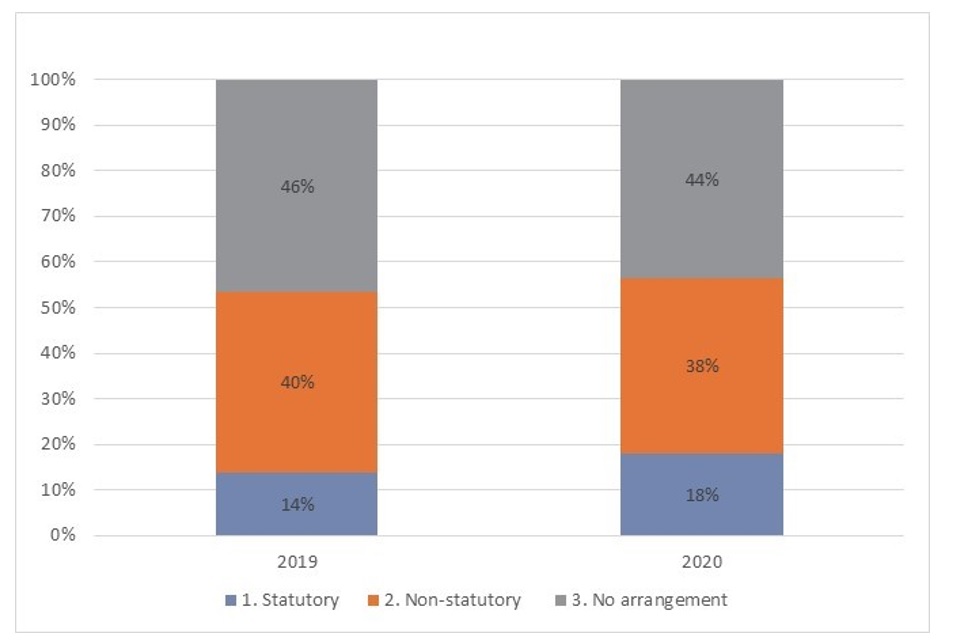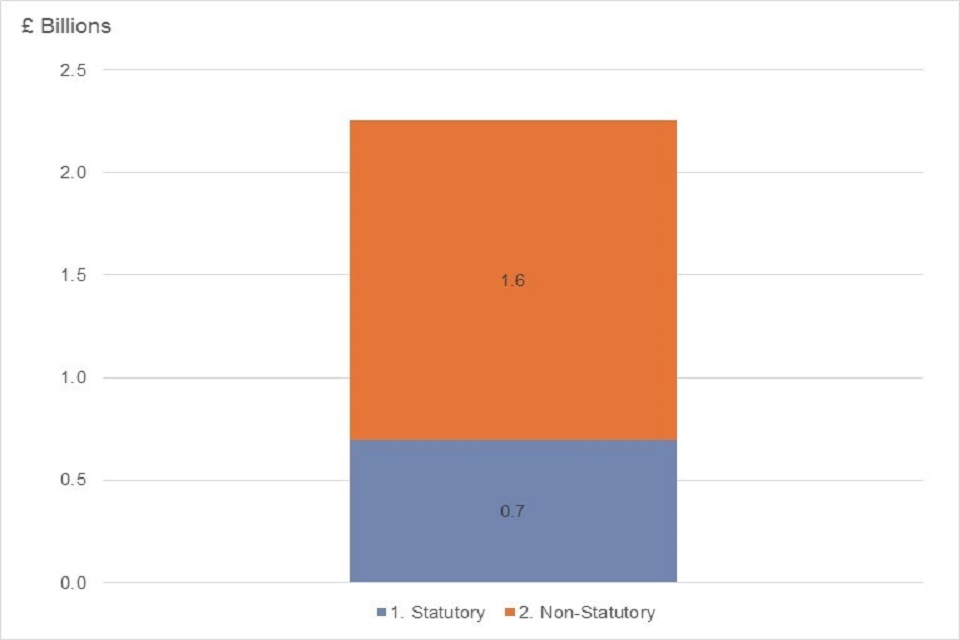Separated families statistics: April 2014 to March 2020
Published 25 March 2021
The latest release of these statistics can be found in the collection of separated families statistics.
This is a release of annual statistics on separated families in Great Britain.
These statistics have been developed using guidelines set out by the UK Statistics Authority and are official statistics undergoing development. They have therefore been designated as experimental statistics.
This current publication contains new estimates covering the financial years ending 2019 and 2020. Methodological changes introduced as a result of the closure of all ongoing Child Support Agency (CSA) cases mean the population and arrangement estimates from 2019 onwards are not directly comparable to earlier years. Further information is available in the background and methodology note.
The next release is planned for March or April 2022.
1. Introduction
The Department for Work and Pensions’ (DWP) Single Departmental Plan includes a strategic objective to continue to provide a Child Maintenance system. This system supports separated parents to work together to set up family based child maintenance arrangements, and where this is not possible, provides access to an effective and efficient Child Maintenance Service to ensure separated parents contribute towards the upkeep of their children. This publication provides statistical estimates relating to separated families and their child maintenance arrangements. In this publication the latest time period is extended by 2 years to the financial year ending 2020. This makes the overall publication more timely and in line with other products using data from the Family Resources Survey.
This publication provides new estimates relating to the financial years ending 2018, 2019 and 2020. Older estimates back to 2015 are also shown in the accompanying tables but remain unchanged from the previous publication. Depending on the analysis, statistics may be derived from three-year averages or shown as single years.
These statistics provide estimates of the following:
- the number of separated families in Great Britain and the number of children in those families
- the proportion of separated families with a child maintenance arrangement and whether this is statutory or non-statutory
- the total amount of child maintenance received by Parents With Care, by arrangement type
- the net impact of child maintenance payments on the number of children in low income households
- breakdowns of the Parents With Care Population by age and gender
In addition, the latest release provides the following estimates for the first time:
- the position of parents in separated families in the income distribution (and where they would be had they not paid or received child maintenance)
- breakdowns of the Non-Resident Parent population by age and gender
It should be noted that there is no requirement for separated families to have a child maintenance arrangement and some families may not want an arrangement. If parents do want an arrangement they may be able to agree this themselves without the involvement of the Child Maintenance Service (CMS). Arrangements made in this way are called non-statutory arrangements or ‘family based arrangements’. Where parents want an arrangement but need help with this, support is available through the Child Maintenance Options service.

2. Main stories
In the latest financial year ending 2020 it is estimated that:
- there were 2.4 million separated families in Great Britain including 3.6 million children in separated families
- 56% of separated families had a child maintenance arrangement
In the latest three-year period covering financial years ending 2018 to 2020, it is estimated that;
- Parents With Care in separated families received a total of £2.3 billion annually in child maintenance payments
- 89% of Parents With Care were female and under the age of 50
- 86% of Non-Resident Parents were male and 80% were under the age of 50
- child maintenance payments reduced the number of children living in low income households annually – as a result of such payments 60 thousand children were moved out of absolute low income on a Before Housing Costs (BHC) basis, and 120 thousand children on an After Housing Costs (AHC) basis
- 3% of Parents With Care moved out of the lowest 20% of the income distribution due to receiving child maintenance AHC, this is 2% BHC
- 4% of Non-Resident Parents moved out of the highest 20% of the income distribution due to paying child maintenance AHC, this is 4% BHC
3. What you need to know
Separated family
A separated family is defined as one Parent With Care, one Non-Resident Parent and any biological or adopted children they have between them who are either under 16 or under 20 and in full-time non-tertiary education.
Parent With Care
A Parent With Care is the parent who has sole or main day-to-day care of any relevant children and who may potentially be eligible to receive child maintenance.
Non-Resident Parent
A Non-Resident Parent is the parent who does not have sole or main day-to-day care of any relevant children and who may be required to pay child maintenance.
Child maintenance arrangement
There are 2 main types of child maintenance arrangement:
- statutory arrangements
- non-statutory arrangements
Separated families may have more than one type of arrangement.
Statutory child maintenance arrangements
Statutory child maintenance arrangements are those which have been arranged with the CMS or its predecessor, the CSA.
Non-statutory arrangements
Non-statutory arrangements include all other arrangements such as:
- voluntary financial arrangements which involve direct monetary payments between parents where the CMS or CSA have not been involved
- voluntary non-financial arrangements involving payments in kind
- other types of arrangements including shared care arrangements
- court orders requiring parents to make financial payments
Child Maintenance Options
Child Maintenance Options is a free service providing impartial information and support to help separated parents make decisions about their child maintenance arrangements. 85% of people who contacted Child Maintenance Options in May to July 2019 had an arrangement 6 months later and around a quarter of these had a non-statutory, family-based arrangement.
Child Maintenance Service (CMS)
The CMS was introduced in December 2012. It replaced the CSA and is for separated parents who can’t arrange child maintenance between themselves. Parents can ask the CMS to calculate the amount of maintenance to be paid and, if necessary, to help manage and collect payments. Since the end of 2018, all CSA cases with on-going liabilities closed. Parents now have the option of setting up a statutory arrangement with the CMS, a non-statutory, family-based arrangement, or choosing not to have an arrangement at all.
Equivalised household income
If a household’s income is equivalised it means that it has been adjusted to make it comparable to other household incomes. Household size and composition is taken into account to make these income estimates comparable.
Low income
A household is said to be in relative low income if their equivalised income is below 60% of median household income, while they are said to be in absolute low income if their equivalised income is below 60% of the median household income adjusted for inflation for the financial year ending 2011. For comparative purposes, both relative and absolute low income are estimated before and after taking housing costs into account.
Income distribution
This shows how equivalised household income is shared through a population. Each equivalised household income will be at a given percentile in the distribution to allow for comparisons with other households.
Income deciles and quintiles
In this publication deciles divide the population, when ranked by equivalised household income, into 10 equal sized groups, and are indicated by 1 to 10, while quintiles divide the population into 5 groups.
4. Separated families and their child maintenance arrangements
It is estimated that for the financial year ending 2020 there were approximately 2.4 million separated families in Great Britain, including 3.6 million children in those separated families.
Separated families by child maintenance arrangement type, for the financial years ending 2019 and 2020

In the financial year ending 2020, 56% of separated families had a child maintenance arrangement – this is 2 percentage points higher than the financial year ending 2019. Due to data and methodological changes outlined in the background and methodology note, comparisons with earlier years are should not be made.
The proportion of separated families with a non-statutory arrangement fell by 2 percentage points to 38% between the financial years ending 2019 and 2020, with statutory arrangements increasing by 4 percentage points over the same period to 18%.
Sources: Family Resources Survey (FRS); CMS and CSA administrative databases (see the accompanying tables for full data).
Notes about these statistics:
- Figures relating to the financial years ending 2019 and 2020 are new and shown for the first time in this publication. All other figures in the accompanying tables remain unchanged from previous publications.
- For simplicity, parents with both statutory and non-statutory arrangements are included in the statutory arrangement group. (see the accompanying tables for full data).
- The statistical significance of year-on-year changes cannot be assessed as estimates are derived from various sources. (see the background information and methodology note).
- Totals may not sum to 100% due to rounding.
Between the financial years ending 2015 to 2017, statutory child maintenance moved from the CSA to the CMS. CSA cases began closing and under CMS more freedom and support was provided to enable parents to choose the arrangement that works best for them. This could be a statutory arrangement or a non-statutory arrangement, and there is no requirement for parents to have an arrangement.
The CSA cases were closed in groups. Those closed first were the simpler cases, such as those with no liability in place. The last cases to close were more complex, such as those where enforcement action was on-going. Any fall in the proportion of separated families with a statutory arrangement may be partly due to the closure of historical CSA cases that were non-compliant or had no ongoing liability.
See accompanying tables for full data. It is not possible to assess whether year-on-year changes are statistically significant as the estimates are derived from various data sources (see the background information and methodology note).
5. The impact of child maintenance payments on the number of children in low income households
The total amount of child maintenance received by Parents With Care, by arrangement type for the financial years ending 2018 to 2020

Sources: Family Resources Survey (FRS); CMS administrative data. See the accompanying tables for full data.
On average it is estimated £2.3 billion in child maintenance payments was received each year by Parents With Care in separated families in the financial years ending 2018 to 2020. Around 70% of these payments related to non-statutory child maintenance arrangements, with around 30% relating to statutory arrangements.
Table 1: The annual impact of child maintenance payments on the number of children in low income households, for the financial years ending 2018 to 2020
| Definition of low income | Net impact on the number of children in low income households (thousands) |
|---|---|
| Relative low income (before housing costs) – below 60% of contemporary median household income | -100 |
| Relative low income (after housing costs) – below 60% of contemporary median household income | -140 |
| Absolute low income (before housing costs) – below 60% of median household income in the financial year ending 2011 held in constant real terms | -60 |
| Absolute low income (after housing costs) – below 60% of median household income in the financial year ending 2011 held in constant real terms | -120 |
Source: Family Resources Survey (FRS). See the accompanying tables for full data.
Notes about Table 1:
- Estimates are rounded to the nearest 20,000.
Child maintenance payments reduced the number of children living in low income households. 120,000 children were moved out of low income households on the absolute low income After Housing Cost measure. Most of this impact related to single parent families.
6. Estimates of the position of parents in separated families in the income distribution (and where they would be had they not paid or received child maintenance)
Parent With Care and Non-Resident Parent positions in the income distributions before and after child maintenance, After Housing Costs, for the financial years ending 2018 to 2020

Considering an After Housing Cost basis, Non-Resident Parents incomes are more evenly spread across their distribution compared to Parents With Care where their distribution is more skewed towards the lowest income quintiles. This situation remains largely unchanged even after child maintenance has be paid from the Non-Resident Parent to the Parent With Care.
After child maintenance has been paid we estimate that the percentage of Parents With Care in the bottom quintile are 3 percentage points lower and Non-Resident Parents in the top quintile are 4 percentage points lower. While child maintenance payments result in a rise in the proportion of Non-Resident Parents in the lowest quintile to 27%, over a third (36%) of Parents With Care still remain in the lowest quintile even after child maintenance is received.
7. About these statistics
These statistics have been developed using guidelines set out by the UK Statistics Authority and are official statistics undergoing development. They have therefore been designated as experimental statistics. We publish these statistics on an annual basis and will continue to expand their scope to help to meet user needs where reliable estimates can be obtained. Users are invited to comment on the development and relevance of these statistics at this stage and can send feedback to: cm.analysis.research@dwp.gov.uk.
These GB–level statistics are estimates based primarily on data from the Family Resources Survey (FRS). The FRS is based on a representative sample of around 19,000 United Kingdom (UK) households. The FRS is a continuous survey which collects information on the income, characteristics and circumstances of individuals living in a representative sample of private households in the UK. FRS respondents are asked about the relationships within their household and any child maintenance arrangements they may have. Their responses are used to determine whether they are members of a separated family, how many children are in that family, the types of child maintenance arrangements they have (if any) and the amount of maintenance they receive.
Where feasible and appropriate, FRS responses regarding child maintenance arrangements are checked for accuracy against the DWP’s CMS and CSA administrative databases and an adjustment for the under-reporting of statutory and non-statutory arrangements is applied.
Estimates of the total amount of child maintenance payments received by Parents With Care are based on a combination of administrative data and unadjusted FRS data.
Estimates of the impact of child maintenance payments on the number of children in low income households are obtained by applying the Household Below Average Income (HBAI) methodology to unadjusted FRS data.
Estimates of the position of parents in separated families in the income distribution are similarly obtained by applying the Household Below Average Income (HBAI) methodology to unadjusted FRS data.
More information about the methodology used to produce these statistics and its limitations can be found in the accompanying background information and methodology note.
Rounding
Figures are rounded to the nearest 100,000, except those relating to the impact of child maintenance payments on the number of children in low income households which are rounded to the nearest 20,000. Monetary amounts are rounded to the nearest hundred million pounds. Percentages are calculated using figures prior to rounding and are rounded to the nearest integer. Totals may not sum due to rounding.
Changes made to this publication
The latest release provides the following estimates for the first time:
- the position of parents in separated families in the income distribution (and where they would be had they not paid or received child maintenance)
- breakdowns of the Non-Resident Parent population by age and gender
Planned changes
These statistics are estimates derived using an experimental methodology which will continue to be reviewed and, where feasible, improved. Any future revisions will be clearly indicated and explained in the relevant publication.
8. Where to find out more
More information about these statistics can be found in the accompanying background information and methodology note and accompanying tables.
The DWP Single Departmental Plan includes an indicator based on these statistics (“the proportion of separated families with a child maintenance arrangement”).
More information about the Households Below Average Income methodology.
